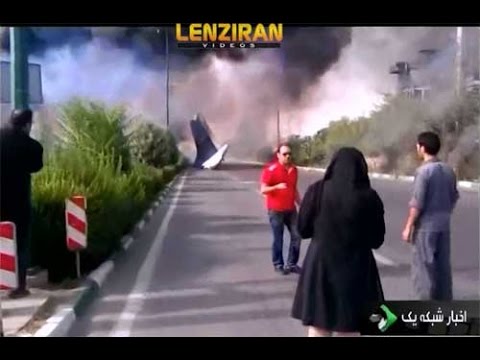On Sunday, 10 August, a plane came down in a residential area near Mehrabad Airport west of Tehran, killing at least 39 people and injuring several others. The plane, which had been headed to Tabas in central Iran, was said to have suffered engine failure on take-off, and crashed into a nearby building.
Eyewitnesses reported the smell of burnt flesh, a cloud of black smoke and a deafening noise. They said several people survived the crash. Most were badly injured and suffering from severe burns. One man, who was reported to have suffered a hemorrhage, said, “My wife and children burned before my eyes. I wish I were dead too”.
Another witness, who lives near the site of the crash, said the plane fell apart as it came down. “When I saw that the plane’s nose was pointing towards the ground and was coming down, I started running,” he said. “I heard a terrible explosion. Then the plane broke up. I was still running when the plane came down.” The pilot was said to have attempted an emergency landing, but without success.
"People rushed on to the scene before the emergency crew arrived to see if they could help survivors,” he said. An emergency helicopter from Tehran’s Air Relief arrived soon after, along with Red Crescent ambulances fire engines. Three were taken to Imam Khomeini Hospital and, according to the Tehran Emergency Services website, six others were taken to another hospital by private ambulance. A relief agency spokesperson told Fars news Agency several people on the ground were also injured when the plane came down.
The propeller airplane, an Iran-140 model version of the Ukrainian Antonov-140, was built by Iran Aircraft Manufacturing Industrial Company (Hesa), owned and operated by Iran’s Defense Ministry. Sunday’s crash was the latest in a series of air accidents in recent years, with ageing aircrafts and under-resourced technology thought to be responsible.
In November 2009, a Iran-140 crashed during a test flight, killing several people. Speaking to Fars News Agency, the head of Defense Ministry’s Industrial Organization said the Iran-140 model had been involved in a string of accidents, including a fatal crash in Isfahan in 2002. He added that the department was working hard to improve the plane’s safety. President Rouhani ordered all Iran-140s to be grounded until an investigation into the accident was complete.
The Iran-140: Not Fit for Purpose
But why is the Iran-140 so prone to accidents? The twin-engine propeller plane bears similarities to other turboprop planes, including the Dutch Fokker-50 and Fokker-27, the French-Italian ATR-72 and the Canadian Bombardier Dash 8. Yet it has a poor safety record and has been involved in a greater number of accidents than other similar models.
Pilot errors and poor construction have been blamed for the Iran-140 failures—with many saying Iran’s aviation industry has not been able to keep up with manufacturing standards on safety and quality, not least because of a lack of resources. But some experts disagree, pointing to Iran’s long-standing aviation industry and its experienced pilots and engineers. One Hesa engineer told IranWire, “A lot of people think that Iran-140 is manufactured domestically but most of the parts are made outside of Iran and are of high quality. Hesa has access to an unlimited amount of hard currency and has no problems in acquiring parts. Yet it still continues to crash.”
Technical experts believe that the problem lies elsewhere. According to the Hesa engineer, the Iran-140’s engine—which was designed 40 years ago—is also used in Russian-designed Klimov TV3-117 and Ukrainian model Antonov An-140. Yet the engine is primarily used in helicopters, including Soviet-designed Kamov Ka-27, Ka-29, Ka-32 and Ka-50, and twin-turbine transport helicopters such as Mil Mi-8 and Mi-28. “In the summertime carrying more than 30 passengers on this plane is dangerous,” an engineer said, adding that it was potentially a “flying coffin”.
“The engine is Iran-140’s main problem,” said a repair and maintenance engineer for the Iranian National Oil Company who now lives in Belgium. “Helicopter engines are the main cause of 80 percent of helicopter accidents,” he added.
He said that, in order to adapt the engine for use in a plane, alterations to the axis must be put in place, which generates high temperatures. In the cold climate of Ukraine, this does not pose a problem. But if the engine is used during a hot and dry Iranian summer, the higher temperatures can affect how the engine performs, with catastrophic results.
An investigation is underway, though there have been widespread assumptions that a “pilot error” will be blamed for the crash in order to cover up the structural problems of Iran-140 and its Klimov engines—and the fact that it continues to be used despite previous accidents and deaths.
News is still emerging about the injured survivors. But with 39 already dead, there will be renewed calls for the Iran-140 to be taken out of circulation altogether.























comments